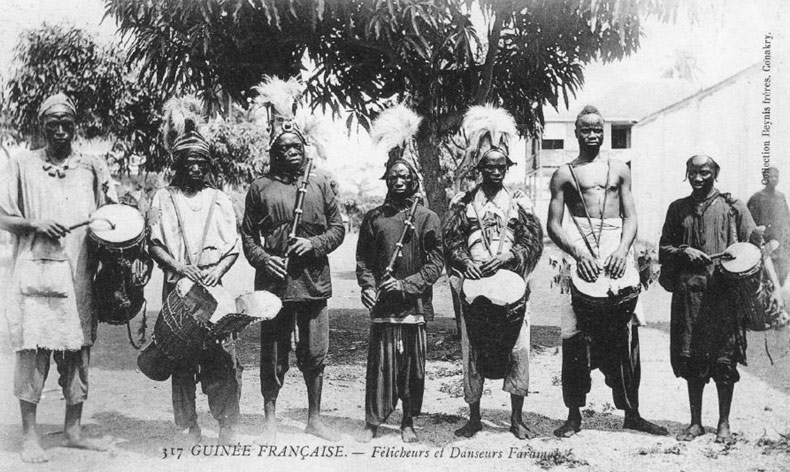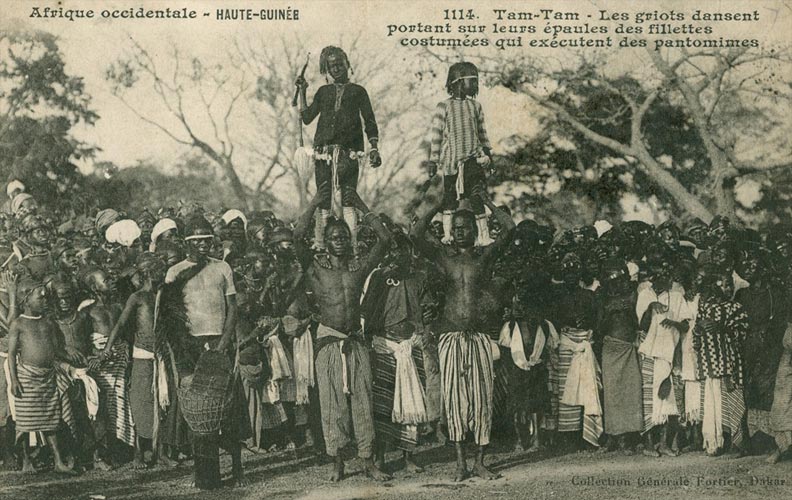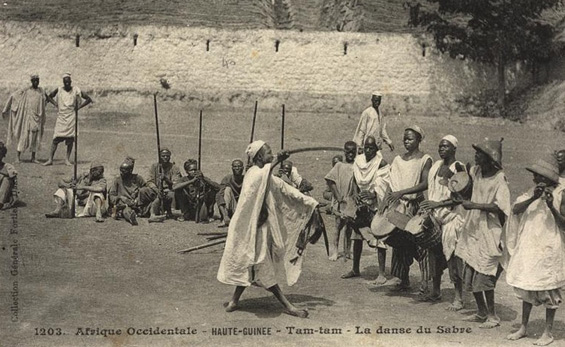DRUMS OF THE WORLD
Africa
Djembe drum West Africa
Djembe drum / Trommel / Tambour West Africa ( with twisted strips of cowhide as rope )
Origin: "There is general agreement that the origin of the djembe is associated with the Mandinka caste of blacksmiths, known as Numu. The wide dispersion of the djembe drum throughout West Africa may be due to Numu migrations during the first millennium AD. Despite the association of the djembe with the Numu, there are no hereditary restrictions on who may become a djembefola (literally, "one who plays the djembe"). This is in contrast to instruments whose use is reserved for members of the griot caste, such as the balafon, kora, and ngoni. (The djembe is not a griot instrument.) Anyone who plays djembe is a djembefola—the term does not imply a particular level of skill. Geographically, the traditional distribution of the djembe is associated with the Mali Empire, which dates back to 1230 AD and included parts of the modern-day countries of Guinea, Mali, Burkina Faso, Ivory Coast, Gambia, and Senegal. However, due to the lack of written records in West African countries, it is unclear whether the djembe predates or postdates the Mali Empire. It seems likely that the history of the djembe reaches back for at least several centuries, and possibly more than a millennium.
Traditional mounting: Originally, the skin was attached by wooden pegs that were driven through holes in the skin and the shell near the playing edge. Four to five people would stretch the wet skin over the drum to apply tension while the pegs were driven into the bowl. The shrinkage of the skin while it dried then applied sufficient additional tension for the skin to resonate. A similar mounting technique is still used by the Landouma (a subgroup of the Baga people) for a djembe-like drum known as a gumbe. This mounting technique most likely goes back hundreds of years; the exact period is unknown. Up until the 1980s, the most common mounting system used twisted strips of cowhide as rope. The skin was attached with rings made of cowhide; one ring was sewn into the perimeter of the skin and a second ring placed below it, with loops holding the skin in place and securing the two rings together. A long strip of cowhide was used to lace up the drum, applying tension between the top ring and a third ring placed around the stem. To apply further tension, the vertical sections of the rope were woven into a diamond pattern that shortens the verticals. Wooden pegs wedged between the shell and the lacing could be used to increase tension still further. The pitch of these traditional djembes was much lower than it is today because the natural materials imposed a limit on the amount of tension that could be applied. Prior to playing, djembefolas heated the skin near the flames of an open fire, which drives moisture out of the skin and causes it to shrink and increase the pitch of the drum. This process had to be repeated frequently, every 15–30 minutes.
Role in the traditional ensemble: Traditionally, the djembe forms an ensemble with a number of other djembes and one or more dunun. Except for the lead (or solo) djembe, all instruments play a recurring rhythmic figure that is known as an accompaniment pattern or accompaniment part. The figure repeats after a certain number of beats, known as a cycle. The most common cycle length is four beats, but cycles often have other lengths, such as two, three, six, eight or more beats. (Some rhythms in the dundunba family from the Hamana region in Guinea have cycle lengths of 16, 24, 28, or 32 beats, among others.) Cycles longer than eight beats are rare for djembe accompaniments—longer cycles are normally played only by the dununba or sangban. Each instrument plays a different rhythmic figure, and the cycle lengths of the different instruments need not necessarily be the same. This interplay results in complex rhythmic patterns (polyrhythms). The different accompaniment parts are played on djembes that are tuned to different pitches; this emphasizes the polyrhythm and creates a composite overall melody. The number of instruments in the ensemble varies with the region and occasion. In Mali, a traditional ensemble often consists of one dunun (called konkoni) and one djembe. The konkoni and djembe are in a rhythmic dialog, with each drum taking turns playing accompaniment while the other instrument plays improvised solos. If a second dunun player is available, he supplements the ensemble with a khassonka dunun, which is a bass drum similar in build to a konkoni, but larger. In Guinea, a typical ensemble uses three djembes and three dunun, called sangban (medium pitch), dundunba (bass pitch), and kenkeni (high pitch, also called kensedeni). If an ensemble includes more than one djembe, the highest pitched (and therefore loudest) djembe plays solo phrases and the other djembes and dunun play accompaniment. An ensemble may have only two dunun, depending on whether a village has enough dunun players and is wealthy enough to afford three dunun. A djembe and dunun ensemble traditionally does not play music for people to simply sit back and listen to. Instead, the ensemble creates rhythm for people to dance, sing, clap, or work to. The western distinction between musicians and audience is inappropriate in a traditional context. A rhythm is rarely played as a performance, but is participatory: musicians, dancers, singers, and onlookers are all part of the ensemble and frequently change roles while the music is in progress. Musicians and participants often form a circle, with the centre of the circle reserved for dancers. Depending on the particular rhythm being played, dances may be performed by groups of men and/or women with choreographed steps, or single dancers may take turns at performing short solos. The lead djembe's role is to play solo phrases that accentuate the movements of the dancers. Often, the aim is to "mark the dancers' feet", that is, to play rhythmic patterns that are synchronized with the dancers' steps. Individual solo dances are not choreographed, with the dancer freely moving in whatever way feels appropriate at that moment. Marking a solo dancer's feet requires the lead djembefola to have strong rapport with the dancer, and it takes many years of experience for a djembefola to acquire the necessary rhythmic repertoire. The lead djembefola also improvises to a rhythm at times when no-one is dancing. While there is considerable freedom in such improvisation, the solo phrases are not random. Instead, individual rhythms have specific key patterns (signature phrases) that the soloist is expected to know and integrate into his improvisation. A skilled soloist will also play phrases that harmonize with the background rhythm (groove) that is created by the other instruments."
Excerpt from: Wikipedia® - https://en.wikipedia.org/wiki/Djembe
Bibliography:
Charry, Eric (2000), Mande Music. Traditional and Modern Music of the Maninka and Mandinka of Western Africa.(University of Chicago Press).
Chernoff, John (1979), African Rhythm and African Sensibility.
Meyer, Andreas (1997), Afrikanische Trommeln. West- und Zentralafrika. Berlin: Veröffentlichungen des Museums für Völkerkunde Berlin.
Polak, Rainer (2004), Festmusik als Arbeit, Trommeln als Beruf. Jenbe-Spieler in einer westafrikanischen Großstadt. Berlin
djembefolas:
Arafan Toure / Fadouba Oularé / Famoudou Konate / Fode "Marseille" Youla / Lamine Soumah / Laurent Camara / Mamady Keita / Ladji Camara / Seny Toure / Sekou Camara / Adama Drame / Amara Kante / Gbanworo Keita / Kassoum Diarra / Seydou "Sidiki" Conde / Soungalo Coulibaly / Zoumana Dembele
Origin: "There is general agreement that the origin of the djembe is associated with the Mandinka caste of blacksmiths, known as Numu. The wide dispersion of the djembe drum throughout West Africa may be due to Numu migrations during the first millennium AD. Despite the association of the djembe with the Numu, there are no hereditary restrictions on who may become a djembefola (literally, "one who plays the djembe"). This is in contrast to instruments whose use is reserved for members of the griot caste, such as the balafon, kora, and ngoni. (The djembe is not a griot instrument.) Anyone who plays djembe is a djembefola—the term does not imply a particular level of skill. Geographically, the traditional distribution of the djembe is associated with the Mali Empire, which dates back to 1230 AD and included parts of the modern-day countries of Guinea, Mali, Burkina Faso, Ivory Coast, Gambia, and Senegal. However, due to the lack of written records in West African countries, it is unclear whether the djembe predates or postdates the Mali Empire. It seems likely that the history of the djembe reaches back for at least several centuries, and possibly more than a millennium.
Traditional mounting: Originally, the skin was attached by wooden pegs that were driven through holes in the skin and the shell near the playing edge. Four to five people would stretch the wet skin over the drum to apply tension while the pegs were driven into the bowl. The shrinkage of the skin while it dried then applied sufficient additional tension for the skin to resonate. A similar mounting technique is still used by the Landouma (a subgroup of the Baga people) for a djembe-like drum known as a gumbe. This mounting technique most likely goes back hundreds of years; the exact period is unknown. Up until the 1980s, the most common mounting system used twisted strips of cowhide as rope. The skin was attached with rings made of cowhide; one ring was sewn into the perimeter of the skin and a second ring placed below it, with loops holding the skin in place and securing the two rings together. A long strip of cowhide was used to lace up the drum, applying tension between the top ring and a third ring placed around the stem. To apply further tension, the vertical sections of the rope were woven into a diamond pattern that shortens the verticals. Wooden pegs wedged between the shell and the lacing could be used to increase tension still further. The pitch of these traditional djembes was much lower than it is today because the natural materials imposed a limit on the amount of tension that could be applied. Prior to playing, djembefolas heated the skin near the flames of an open fire, which drives moisture out of the skin and causes it to shrink and increase the pitch of the drum. This process had to be repeated frequently, every 15–30 minutes.
Role in the traditional ensemble: Traditionally, the djembe forms an ensemble with a number of other djembes and one or more dunun. Except for the lead (or solo) djembe, all instruments play a recurring rhythmic figure that is known as an accompaniment pattern or accompaniment part. The figure repeats after a certain number of beats, known as a cycle. The most common cycle length is four beats, but cycles often have other lengths, such as two, three, six, eight or more beats. (Some rhythms in the dundunba family from the Hamana region in Guinea have cycle lengths of 16, 24, 28, or 32 beats, among others.) Cycles longer than eight beats are rare for djembe accompaniments—longer cycles are normally played only by the dununba or sangban. Each instrument plays a different rhythmic figure, and the cycle lengths of the different instruments need not necessarily be the same. This interplay results in complex rhythmic patterns (polyrhythms). The different accompaniment parts are played on djembes that are tuned to different pitches; this emphasizes the polyrhythm and creates a composite overall melody. The number of instruments in the ensemble varies with the region and occasion. In Mali, a traditional ensemble often consists of one dunun (called konkoni) and one djembe. The konkoni and djembe are in a rhythmic dialog, with each drum taking turns playing accompaniment while the other instrument plays improvised solos. If a second dunun player is available, he supplements the ensemble with a khassonka dunun, which is a bass drum similar in build to a konkoni, but larger. In Guinea, a typical ensemble uses three djembes and three dunun, called sangban (medium pitch), dundunba (bass pitch), and kenkeni (high pitch, also called kensedeni). If an ensemble includes more than one djembe, the highest pitched (and therefore loudest) djembe plays solo phrases and the other djembes and dunun play accompaniment. An ensemble may have only two dunun, depending on whether a village has enough dunun players and is wealthy enough to afford three dunun. A djembe and dunun ensemble traditionally does not play music for people to simply sit back and listen to. Instead, the ensemble creates rhythm for people to dance, sing, clap, or work to. The western distinction between musicians and audience is inappropriate in a traditional context. A rhythm is rarely played as a performance, but is participatory: musicians, dancers, singers, and onlookers are all part of the ensemble and frequently change roles while the music is in progress. Musicians and participants often form a circle, with the centre of the circle reserved for dancers. Depending on the particular rhythm being played, dances may be performed by groups of men and/or women with choreographed steps, or single dancers may take turns at performing short solos. The lead djembe's role is to play solo phrases that accentuate the movements of the dancers. Often, the aim is to "mark the dancers' feet", that is, to play rhythmic patterns that are synchronized with the dancers' steps. Individual solo dances are not choreographed, with the dancer freely moving in whatever way feels appropriate at that moment. Marking a solo dancer's feet requires the lead djembefola to have strong rapport with the dancer, and it takes many years of experience for a djembefola to acquire the necessary rhythmic repertoire. The lead djembefola also improvises to a rhythm at times when no-one is dancing. While there is considerable freedom in such improvisation, the solo phrases are not random. Instead, individual rhythms have specific key patterns (signature phrases) that the soloist is expected to know and integrate into his improvisation. A skilled soloist will also play phrases that harmonize with the background rhythm (groove) that is created by the other instruments."
Excerpt from: Wikipedia® - https://en.wikipedia.org/wiki/Djembe
Bibliography:
Charry, Eric (2000), Mande Music. Traditional and Modern Music of the Maninka and Mandinka of Western Africa.(University of Chicago Press).
Chernoff, John (1979), African Rhythm and African Sensibility.
Meyer, Andreas (1997), Afrikanische Trommeln. West- und Zentralafrika. Berlin: Veröffentlichungen des Museums für Völkerkunde Berlin.
Polak, Rainer (2004), Festmusik als Arbeit, Trommeln als Beruf. Jenbe-Spieler in einer westafrikanischen Großstadt. Berlin
djembefolas:
Arafan Toure / Fadouba Oularé / Famoudou Konate / Fode "Marseille" Youla / Lamine Soumah / Laurent Camara / Mamady Keita / Ladji Camara / Seny Toure / Sekou Camara / Adama Drame / Amara Kante / Gbanworo Keita / Kassoum Diarra / Seydou "Sidiki" Conde / Soungalo Coulibaly / Zoumana Dembele



